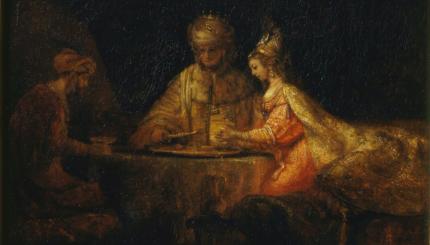Recently, I was poring over some of the stories of famous women in the Bible — the matriarchs (Sarah, Rebecca, Rachel and Leah), Queen Esther and others — and a detail, one that I had not previously noticed, caught my attention. All of these women are described as physically beautiful. Sarah, Abraham’s wife, is so beautiful that Abraham has to lie and declare he is her brother, rather than her husband, for fear that the Egyptians will kill him in order to claim her— a fear that is proven to be well founded when she is kidnapped and taken to Pharaoh.
Rebecca is described as “very fair to look upon” and “a virgin” when Abraham’s servant first meets her on his quest for a wife for Isaac. Rachel, too, was beautiful; in her introduction, the text lauds her as “of beautiful form and fair to look upon.” Queen Esther is also a paradigm of beauty— in fact, her physical appearance is a central facet as a character in the story: It is this outward beauty that causes King Ahasuerus to choose her, over all the other women, as his new wife.
Lauded For Their Beauty
Intrigued, I began to look for other instances of beauty in the Bible…and realized that it is not only the women whose attractiveness is noted. Male characters are lauded for their physical appearances as well— Joseph, King David and David’s son, Absalom, are a few examples. Altogether, the number of times in which the biblical text goes out of its way to inform readers that characters are attractive— from figures as famous as the matriarchs to those as obscure as Job’s daughters— is astonishing.
What was puzzling, to me, was the intent of the text. All of this emphasis on physical appearance would, naturally, seem to imply that beauty is an inherent value in Judaism (at least, from the biblical perspective).

Help us keep Jewish knowledge accessible to millions of people around the world.
Your donation to My Jewish Learning fuels endless journeys of Jewish discovery. With your help, My Jewish Learning can continue to provide nonstop opportunities for learning, connection and growth.
Yet this conflicts with all of the Jewish values I have ever been taught including aphorisms and fables that stress the importance of inner beauty, character and integrity, rather than what is on the outside. And, in fact, this dismissal of outer in favor of inner beauty stems from the Bible itself; every Friday night, we quote Proverbs as we proclaim, “sheker hahen v’hevel hayofi — isha yirat hashem hi tithallal— Grace is deceitful, and beauty is vain; but a woman that feareth the Lord, she shall be praised.” How, then, can one reconcile these two seemingly contradictory ideals?
Physical Characteristics Highlight Internal Traits
One approach is to view beauty in the Bible as a literary technique; in other words, the Bible mentions the physical characteristics of certain personas to highlight internal traits. For instance, Rebecca’s beauty seems connected, in the text, to her moral character.
We are told that Rebecca is beautiful in our first introduction to her: “And the damsel was very fair to look upon, a virgin, neither had any man known her;” yet the end of the sentence continues, “and she went down to the fountain, and filled her pitcher, and came up.”
The next few verses describe how Rebecca passes the ethical test that Abraham’s servant set— she not only offers water to the stranger but to his camels as well.
In other words, the description of Rebecca’s physical beauty is juxtaposed with a depiction of her moral fiber. Even the emphasis on her virginity, although it could be read as simply a further illustration of her comeliness (the iconic virgin as the epitome of “beauty”), more simply reads as a statement regarding her modesty— a modesty that is all the more highlighted by the fact that she is beautiful, yet does not engage in promiscuous behavior. Rebecca’s physical beauty, therefore, emphasizes her upstanding character.
A Description May Reflect Conceit
The emphasis on the beauty of King David’s son, Absalom, in contrast, seems to highlight his vanity:
Now in all Israel there was none to be so much praised as Absalom for his beauty; from the sole of his foot even to the crown of his head there was no blemish in him. And when he polled his head—now it was at every year’s end that he polled it; because the hair was heavy on him, therefore he polled it— he weighed the hair of his head at two hundred shekels, after the king’s weight.
Was there literally no other man in all of Israel who was as beautiful as Absalom? Or was that simply how he viewed himself?
The tone of the text is lightly mocking; note the formality of the “polling” of his hair— an annual event— and the double entendre of “shekels,” which act as a unit of weight, but also refer to a monetary currency. Perhaps these verses critique not only Absalom’s implied physical vanity but also his more general sense of entitlement— a trait that becomes explicit through his rebellion against David.Yet another example of beauty imagery as a literary tool are the appearances of Rachel and Joseph.
Both are described as “of beautiful form and fair to look upon;” in fact, Joseph’s beauty is described in exactly the same terms as his mother’s. This parallel description highlights what is, perhaps, a slight critique of Jacob — for Rachel’s beauty presumably contributed to Jacob’s greater love for her over Leah, and, so too, it was that resemblance and connection to Rachel that caused Jacob to favor Joseph over his brothers.
Reading every mention of physical beauty in the Bible as a coded commentary on a character’s personality can become reductive. For many figures— Sarah, Rachel, David, Esther and others— the description of their attractiveness does not appear to be directly linked to any question of their moral fiber. What it is linked to, however, is narrative necessity.
Beautiful for a Purpose
Every time a character is described as attractive, it is for a purpose: Sarah, so that we understand why Pharaoh’s servants kidnap her; Rachel’s beauty arguably explains, perhaps, Jacob’s favoring of her over Leah. Joseph’s beauty is described immediately preceding Potiphar’s wife’s attempts to seduce him, as is the beauty of Tamar, King David’s daughter, before her half-brother Amnon rapes her.
Batsheva’s beauty serves to help us understand why David was so overcome with desire for her that he took Batsheva and sent her husband to die in battle; the beauty of Queen Esther and (the often overlooked) Vashti caused them to be chosen as wives for Ahasuerus.
King David is described as “ruddy, and handsome,” as a “comely person,” and as “of a fair countenance.” His beauty serves multiple purposes: It is a factor that causes Goliath to mock David, and it is one of the qualities by which he is recommended to Saul as a harp player.
Most importantly, however, it appears in the text immediately following God’s admonition of Samuel: “Look not on [Eliav’s] countenance, or on the height of his stature; because I have rejected him.” Given Samuel’s instinctive choice of David’s brother Eliav as a king and Goliath’s mocking of David’s “pretty boy” appearance, one might arrive at a counter-intuitive notion: although we usually think of beauty as an ideal, in this situation when Samuel has to choose a king and military leader for Israel, beautiful features would seem to represent the opposite of what one would want from a battle hero.
Yet God tells Samuel that David is the right man for the job, despite his outer appearance, and it is precisely David’s unthreatening image that causes Goliath to underestimate him.
This is not to say that plot necessity obviates the literary readings of beauty imagery previously mentioned. To the contrary, various understandings of beauty often overlap with the narrative’s purposes.
Rebecca’s moral excellence is, in fact, a plot necessity— because Abraham’s servant is searching for a woman of strong moral character, the text emphasizes not only Rebecca’s kindness (as shown by her drawing water for the animals as well as for Abraham’s servant) but also her modesty (i.e., the fact that, even though she was beautiful, she still refrained from promiscuous behavior, and was “untouched by a man”).
Similarly, Absalom’s vanity and impetuousness are also essential to the plot, in both a general sense–his very self-centeredness and impetuousness contribute to his rebellion against David— and in a literal sense, as his exceptionally long hair ironically causes his demise.
What an understanding of beauty as a narrative tool does explain, however, is the seeming incongruity of the plethora of attractive characters throughout the Bible and the sharp dismissal of outer appearance in favor of inner morality found in Proverbs. The latter offers us a value judgment— that physical “beauty” is false and that a woman who fears God is to be lauded. The narratives, in contrast, do not offer us value judgments.
If beauty were meant as a value to be praised, then why would not figures such as Moses, Deborah and Ruth also be described as “beautiful?” The opportunity is there— we know that Moses is humble, Deborah, presumably wise, and Ruth a woman of good deeds. Rather, the narratives mention a character’s beauty when it is crucial for plot development–either to highlight specific character traits or, more often, simply because physical appearance in and of itself is a critical plot factor.
Beauty As a Moral Lesson
Physicality is an inescapable component of reality. The Bible is quite open about beauty and the sometimes unfortunate consequences of lust or even of misplaced love. That is one of the inspiring elements of the Bible— its honesty regarding human frailties and emotions.
Yet, to misread the instances of beauty in the Bible as lessons about the value of appearance does a disservice to the text, as well as to traditional Jewish values. As the verse describing the choosing of King David explains:
Look not on [Eliav’s] countenance or on the height of his stature; because I have rejected him; for it is not as man seeth: for man looketh on the outward appearance, but the LORD looketh on the heart.
The Bible may include descriptions of characters’ outward appearances so that the resulting narrative makes sense to readers; at times these depictions may also reflect positive or negative lessons about the character’s personality.
Yet, these narratives serve a fundamentally different purpose than the pedagogic advice of Proverbs. Whereas the Bible generally introduces beauty to explain a story line, Proverbs introduces beauty to highlight a moral lesson – that it is not the outer appearance that matters, from a Jewish perspective. Rather, it is the inner moral fiber of a person — and his or her fearing of God— that establishes, in truth, one’s praiseworthiness and valor.
Reprinted with permission from JOFA, The Jewish Orthodox Feminist Alliance.



